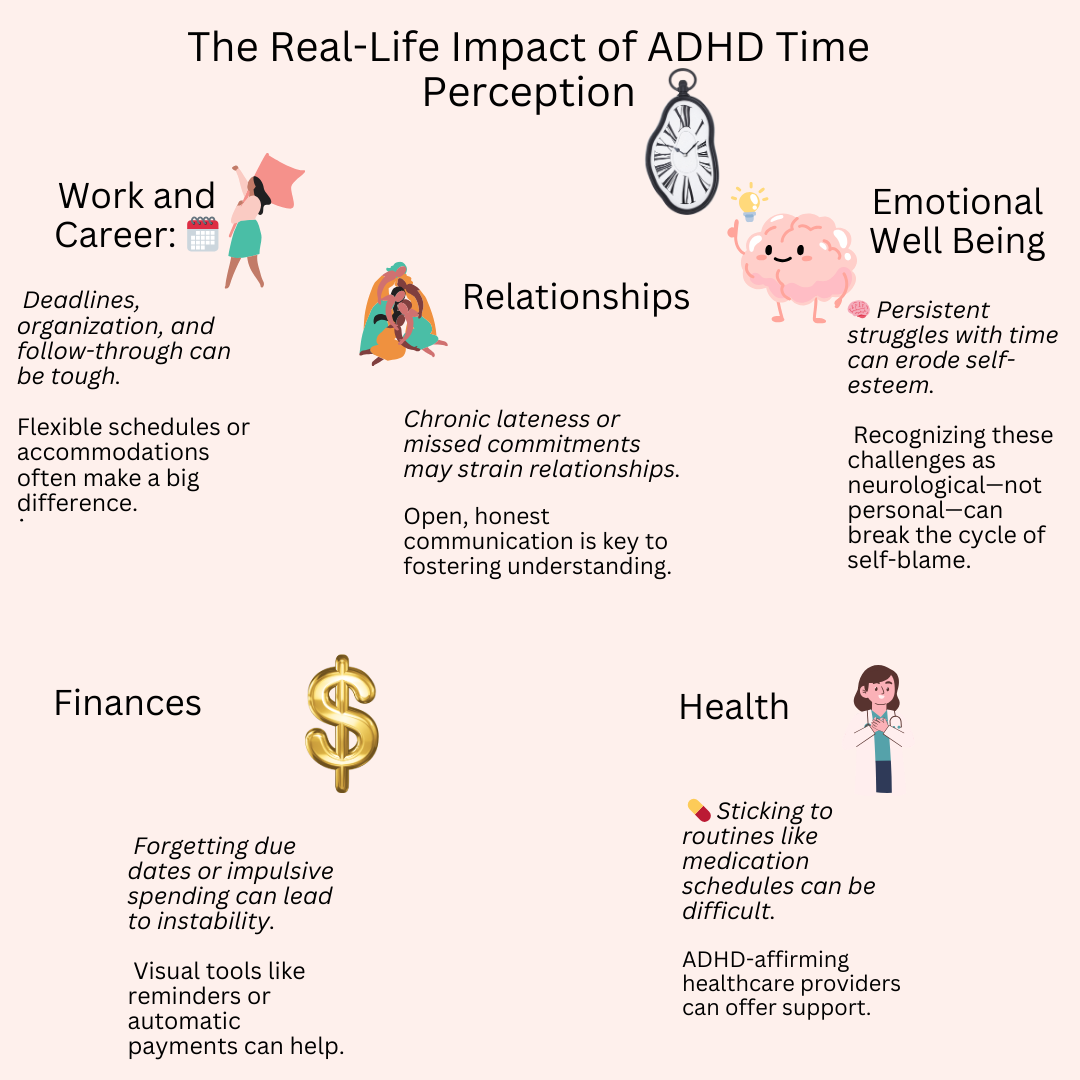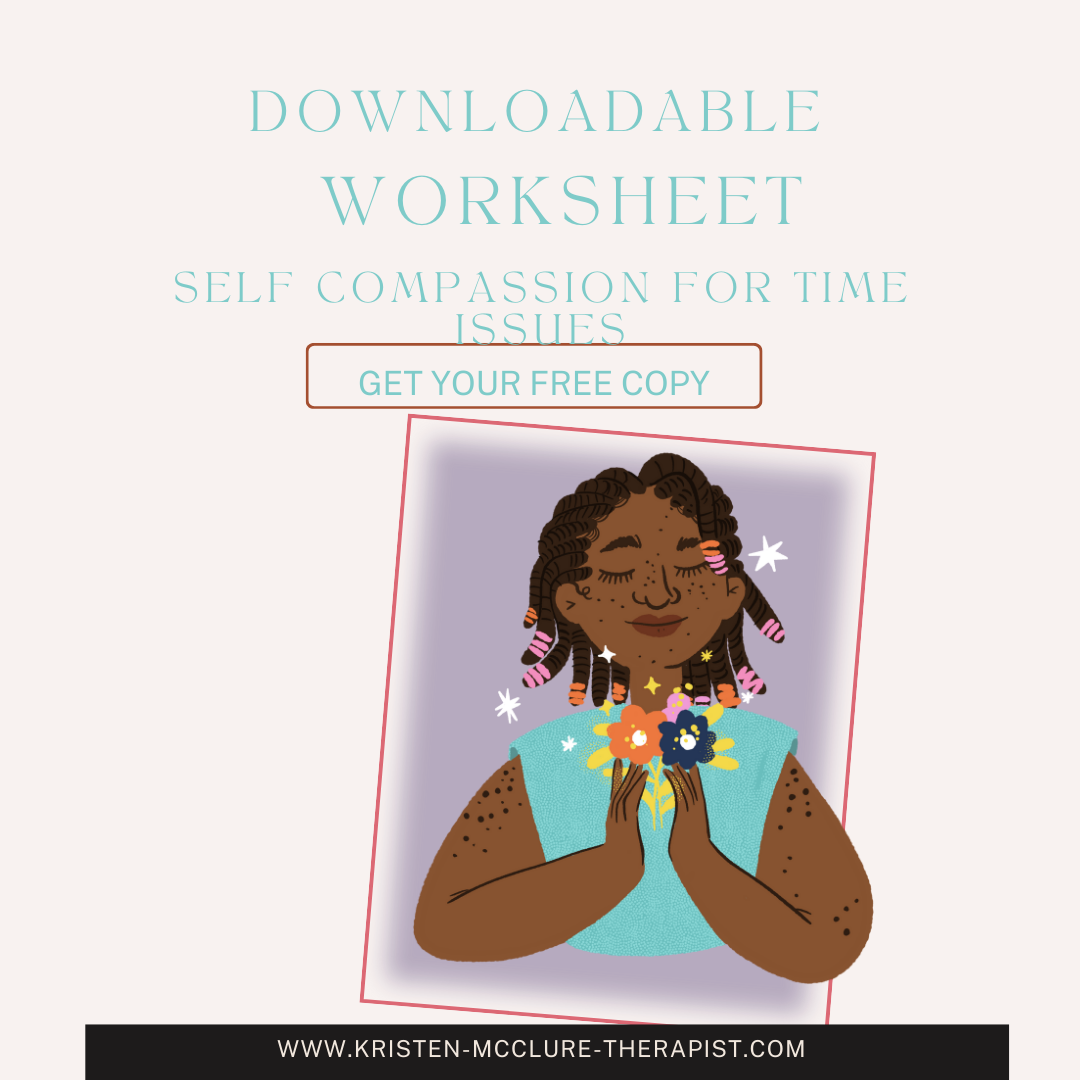5 Key Ways ADHD Women Experience Time Differently– And Why It Matters
Time can feel slippery for women with ADHD. While many people rely on an internal clock and a future-focused mindset, ADHD rewires how time is experienced, often creating unique challenges. These differences ripple across daily life, relationships, and overall well-being. Let’s explore how ADHD shapes time perception, why it matters, and how women with ADHD can thrive in a world that prioritizes traditional time structures.
Why Time Perception Differences in ADHD Women Matter
For women with ADHD, struggles with time often lead to unfair labels like "lazy" or "irresponsible." These challenges stem from differences in the ADHD brain, not a lack of effort or care. By understanding how ADHD women experience time, we can embrace these differences, create practical solutions, and foster self-compassion.
How ADHD Shapes Time Perception
Here are five key ways ADHD influences how women perceive and manage time:
- Living in the Now
ADHD brains often prioritize the present over the future, making long-term goals feel more abstract. They also make decisions driven by immediate gratification. Russel Barkley has done the most research in this area, and his model has helped us understand this. - A Difficult Relationship with the Past
ADHD women may dwell on past mistakes while forgetting positive experiences. Studies, like those using the Swedish Zimbardo Time Perspective Inventory, show they score higher on "Past Negative" scales than neurotypical individuals. This can hinder confidence and growth, but recognizing these patterns is a first step toward self-compassion. - Challenges in Time Management
Estimating task durations, meeting deadlines, and prioritizing effectively are everyday struggles. Hormonal shifts, like those during the menstrual cycle, can complicate time management. While medications can help, individualized strategies are often necessary. - Distorted Time Perception
Events might seem to drag on forever or fly by, making it hard to judge time accurately. Hyperfocus on some tasks and neglect of others create an inconsistent rhythm in daily life. - The Reality of “Time Blindness”
Difficulty aligning with traditional time structures makes planning and organizing especially hard. Tools like timers or calendars often fall short, highlighting the need for ADHD-specific strategies.

The Real-Life Impact of ADHD Time Perception
Time challenges affect many areas of life, including:
-
- Work and Career: 🗓️ Deadlines, organization, and follow-through can be tough. Flexible schedules or accommodations often make a big difference.
-
- Relationships: 💬 Chronic lateness or missed commitments may strain relationships. Open, honest communication is key to fostering understanding.
-
- Finances: 💸 Forgetting due dates or impulsive spending can lead to instability. Visual tools like reminders or automatic payments can help.
-
- Health and Safety: 💊 Sticking to routines like medication schedules can be difficult. ADHD-affirming healthcare providers can offer support.
-
- Emotional Well-being: 🧠 Persistent struggles with time can erode self-esteem, but recognizing these challenges as neurological—not personal—can break the cycle of self-blame.
Practical Strategies for Navigating Time May Help Some
- Visualize Time
Use tools like color-coded planners, visual timers, or time-blocking to make time feel more tangible and manageable. - Anchor Tasks to Cues
Pair activities with familiar events (e.g., "start cleaning after coffee") to create a natural structure. - Break Tasks into Small Steps
Divide big projects into smaller, actionable pieces. Celebrating small wins helps maintain motivation and counter negative self-talk. - Leverage Rewards
Boost dopamine by rewarding task completion with enjoyable activities, like listening to music or taking a short walk. - Seek Professional Support
ADHD coaches or therapists who understand women’s unique challenges can provide tailored strategies in a judgment-free way.
Self-Compassion Is Essential
Time struggles reflect how ADHD brains work—not a moral failing.
It’s essential to treat yourself with the kindness you’d show a friend. Recognizing and validating your experiences is critical to building a healthier relationship with time.

Download my free worksheet SELF COMPASSION FOR ADHD and Time Perception
How Loved Ones Can Help
Friends and family play a vital role by:
- Being Patient: Time challenges aren’t personal. Understanding this fosters empathy.
- Offering Solutions: Shared calendars, visual aids, or co-created routines can reduce stress.
- Learning About ADHD: Educating themselves helps loved ones provide more meaningful support.
Did You Know?
Time struggles in ADHD are rooted in neuroscience.
Differences in dopamine levels affect how the ADHD brain processes time, making it harder to manage abstract concepts like "later." Understanding this can reduce self-blame—it’s about brain chemistry, not willpower.
By recognizing how ADHD influences time, women can shift from frustration to empowerment. With the right tools, support, and mindset, ADHD women can be more understanding and supportive of themselves when grappling with this issue.
Sources I consulted in writing this article
- Chen, J., & Lee, I. (n.d.). BananaNab: Using non-traditional time visualizations to mitigate time blindness in ADHD individuals. Stanford University.
- This study explores innovative tools like BananaNab to support individuals with ADHD in managing time blindness through unconventional visual representations.
- Carelli, M. G., & Wiberg, B. (2011). Time out of mind: Temporal perspective in adults with ADHD. Journal of Attention Disorders, XX(X), 1–7. https://doi.org/10.1177/1087054711398861
- This research investigates how ADHD alters time perception and its connection to executive function, using measures like the Swedish Zimbardo Time Perspective Inventory.


